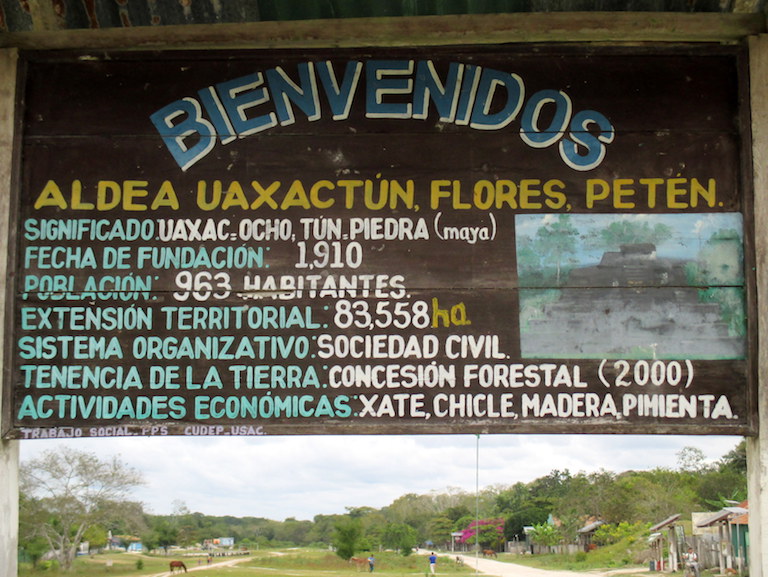- Concerned that wood used in guitars and other instruments be sustainably sourced, members of the American bands Maroon 5 and Guster visited Guatemala’s Maya Biosphere Reserve in December.
- While there they met with governmental officials, the Association of Forest Communities of Peten, and locals involved in the harvest, processing, and export of certified wood from community forest concessions.
- Citing reduced deforestation and benefits to communities in the concessions, the musicans urged Guatemalan president Jimmy Morales to extend the concessions’ contracts, several of which are set to expire within the next decade.
Guatemalan communities engaged in sustainable forestry in the Maya Biosphere Reserve have rallied some high-profile supporters. Musicians from multiple Grammy Award winning pop group Maroon 5 have spoken out for the renewal of community forest concession contracts in the wake of their visit to the area late last year.
“The trip was unforgettable and confirmed what data has demonstrated; community concessions in Guatemala have maintained forest cover, deterred deforestation, and minimized forest fires, all while maintaining the health and biodiversity of ecosystems,” the musicians wrote in a letter to Guatemalan president Jimmy Morales.
Maroon 5 guitarist James Valentine, the group’s pianist and guitarist Jesse Carmichael, and alt-rock band Guster guitarist and singer Adam Gardner visited Guatemala last December. They met with governmental officials, the Association of Forest Communities of Peten (ACOFOP), and locals involved in the harvest, processing, and export of certified wood from community forest concessions.
“We saw firsthand that the benefits of community forest management extend not only to the forests, but also to Guatemalan communities,” the musicians wrote. Their letter to the president was penned in February, presented to Morales in March, and publicly released March 29.

Larger than Belize or El Salvador, the Maya Biosphere Reserve covers the northern fifth of Guatemala. Located in the department of Peten, it is home to rainforest, wetlands, and species such as the endangered Baird’s tapir (Tapirus bairdii) and the iconic scarlet macaw (Ara macao). It is also home to roughly 180,000 people living in the southern buffer zone, the multi-use zone where controlled forestry activities are permitted, and, to a much lesser extent, the core zone comprised of national parks and nature reserves.
Eleven community forest concessions are located in the multi-use zone of the Maya Biosphere Reserve. Organized in co-operatives, local residents engage in the harvest of timber and non-timber forest products. Forest activities in the concessions are regulated by Guatemala’s National Protected Areas Council (CONAP), and certification by the Forest Stewardship Council (FSC) is a requirement.
“Local communities taking care of their own backyards is a really effective way to protect these forests,” Valentine said in a statement. “It’s in the communities’ interests to preserve these forests for future generations.”
Research showing the benefits of community-managed forests is piling up. A 2014 report by Washington, D.C.-based NGOs World Resource Institute (WRI) and Rights and Resources Initiative concluded that lands held by communities and indigenous peoples are sigificantly less impacted by deforestation than privately owned lands or even government-managed protected areas. A 2015 report by WRI found that investing in forest rights for indigenous peoples and local communities can result in huge economic benefits in averted carbon-dioxide emissions.
The long-term benefits of the community forest concessions in Guatemala may be at risk, however, as several of the 25-year concession contracts are set to expire within the next decade. Valentine, Carmichael, and Gardner have joined communities, ACOFOP, and other organizations in calling on the Guatemalan government to ensure the future of the community forestry model.
“We sincerely hope that during your presidency, community concession contracts will be extended in their totality, as is the desire of the organizations managing the concessions,” the musicians wrote in their letter to Morales.

The Maroon 5 and Guster musicians coordinated their trip with the Environmental Investigation Agency (EIA), an NGO with offices in Washington, D.C. and London, and Reverb, a Maine-based non-profit organization co-founded by Gardner that works with musicians and others in the music industry to reduce the environmental impact of tours.
Musicians also have a direct connection to the issue of logging practices due to the tonewoods used in guitars and other instruments. Maroon 5 has joined Mick Jagger, Sting, and dozens of other artists and bands who have signed Reverb’s musician’s pledge, calling on everyone involved in the sourcing, crafting, and production of musical instruments to join them in committing to eliminate trade in illegally logged timber.
C.F. Martin & Co., Gibson Brands, and other guitar manufacturers have used certified wood from community forest concessions in the Maya Biosphere Reserve, including Uaxactún. “There are companies that have been coming here for years,” Uaxactún co-operative forestry manager Marlon Palma told Mongabay in an interview in his office last month. Big-leaf mahogany (Swietenia macrophylla), the concession’s most highly prized export, is one of the species used for guitar bodies and necks.
Members of the EIA and Reverb delegation will return to Guatemala in May to launch a video documenting the Maroon 5 and Guster musicians’ visit to the community forest concessions. The musicians’ involvement also has the potential to spark a broader conversation and impact, EIA senior policy advisor Lisa Handy told Mongabay via email.
“These talented and highly visible artists are uniquely positioned to help transform this sector into a powerful motivator for legally sourcing timber, as millions of consumers learn they can and should ask questions to ensure the wood products they purchase are legally and sustainably sourced,” she said.
Disclosure: The World Resources Institute is a Mongabay funder but provides no editorial input in our reporting.
Citations
- Gray, E., Veit, P.G., Altamirano, J.C. et al. (2015). The Economic Costs and Benefits of Securing Community Forest Tenure: Evidence from Brazil and Guatemala. Washington, D.C.: World Resources Institute.
- Stevens, C., Winterbottom, R., Reytar, K., Springer, J. (2014). Securing Rights, Combating Climate Change: How Strengthening Community Forest Rights Mitigates Climate Change. Washington, D.C.: World Resources Institute, Rights and Resources Initiative.